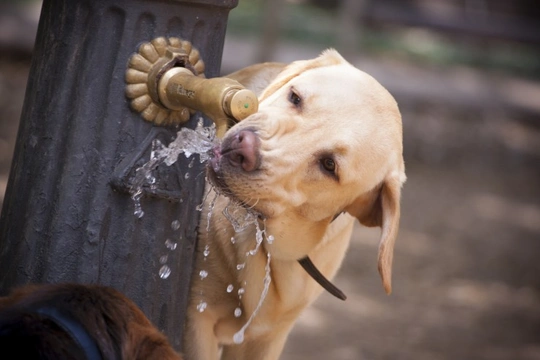
Six water sources that your dog should not drink from
Keeping your dog hydrated at all times is very important, to ensure that they are healthy, do not become dehydrated, do not overheat, and can gain the full value of the nutrition from their food. This means that your dog should have free access to safe, clean water at all times, and that their bowls should be washed up daily in hot water, with the water replaced and replenished at least twice a day. Even when you are outside of the home for any length of time, you should carry water and a bowl with you for your dog to drink from, and offer them water regularly throughout the day.
Natural watercourses that you may come across when you are out and about, such as streams, canals and ponds should not be considered as a good alternative to fresh water, and you should also discourage your dog from drinking from puddles and other unknown sources when they are out and about too.
In this article, we will look at six sources of water that your dog should not drink from. Read on to learn more.
Snow or melted ice
There are a huge number of reasons behind why allowing your dog to eat or drink ice or snow (or melted ice or snow) is not a good idea, although one exception to this rule is adding ice cubes from your freezer to your dog’s dish in hot weather.
Snow and ice that is melting can contain all kinds of nasty substances such as pollutants, gritting agents and antifreeze, and even if the source appears clean, this is no guarantee of safety. Added to this, snow or ice will be cold to drink, quickly lowering your dog’s internal temperature, which can be a problem. Finally, if your dog gets used to picking up pieces of ice, they may also accidentally mistake glass for ice, risking a possibly serious injury.
Stagnant ponds and pools
Stagnant ponds and pools of water are unsuitable for dogs, due to the potential range of toxins and pollutants that may be present in them. Runoff from fertilizer on the fields all end up in surface water, and high levels of bacteria and toxins such as blue-green algae may be present within the water, all of which can make your dog very sick. Avoid canals, lakes and small ponds of unknown provenance.
Salt water
A trip to the beach with your dog can make for an excellent day out, particularly if your dog likes the water and enjoys swimming or paddling. However, salt water is not a suitable water source for dogs for obvious reasons, and drinking seawater or other salt water sources will soon dehydrate your dog further, and potentially make them sick too. Always take fresh water with you on trips to the beach, unless you know for sure that there is a tap nearby that you can use for water.
Dirty tap water
Fresh water straight from the tap is fine for your dog, but tap water that has been sitting out for ages is no good! You should replace the water in your dog’s bowl each day rather than topping up a dirty bowl, and if you carry water in bottles when out for walks, this too should be replaced daily as well.
Also, remember that even if you are conscientious about providing fresh tap water to your dog, if the bowls that you give them water in are dirty or contaminated, this is tantamount to giving your dog dirty water in itself, and so your cleaning and care protocols when it comes to your dog’s water bowls and bottles should be treated in the same way that you would your own.
Also, if your dog is apt to drink from the toilet bowl, keep the lid closed at all times when not in use!
Chlorinated or treated water
Tap water contains a certain amount of chlorine that is fine for consumption, but otherwise, chlorinated water is unsuitable for dogs! This means that your dog should not drink from a swimming pool or a fish pond, as even outdoor ponds may have been treated with medications or water treatment agents to provide a suitable environment for the resident fish. If you are unsure about what is in the water, steer clear.
Puddles
Finally, puddles. Many dogs will lap from puddles when they are out walking, and they will often seek out such sources of water as they tend to contain recently fallen rain, which is often appealing to dogs.
But it is important to remember that the ground is not clean itself, and so lapping from a puddle or shallow pool can mean that your dog is drinking in toxins, bacteria and other potentially dangerous substances too.
While the vast majority of dogs will drink from puddles without any problems and you cannot always stop them from doing this, ensure that you carry a bottle of water with you as an alternative, so that your dog has a better option if they get thirsty when out on a walk.



